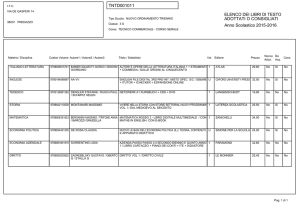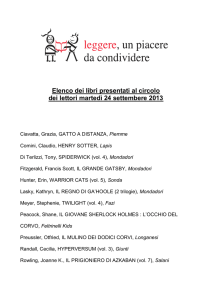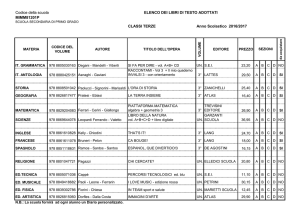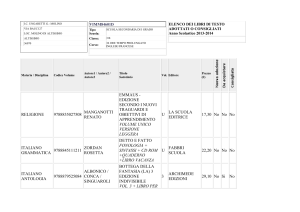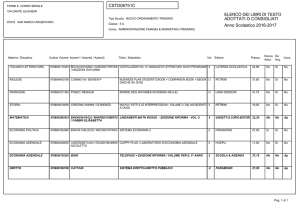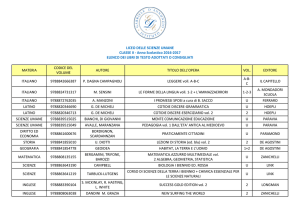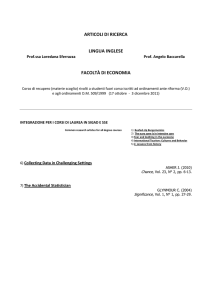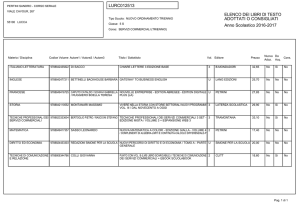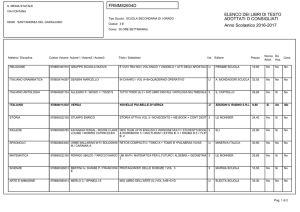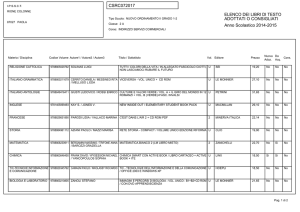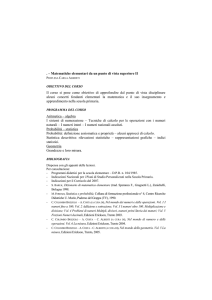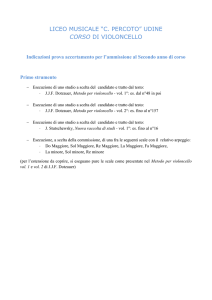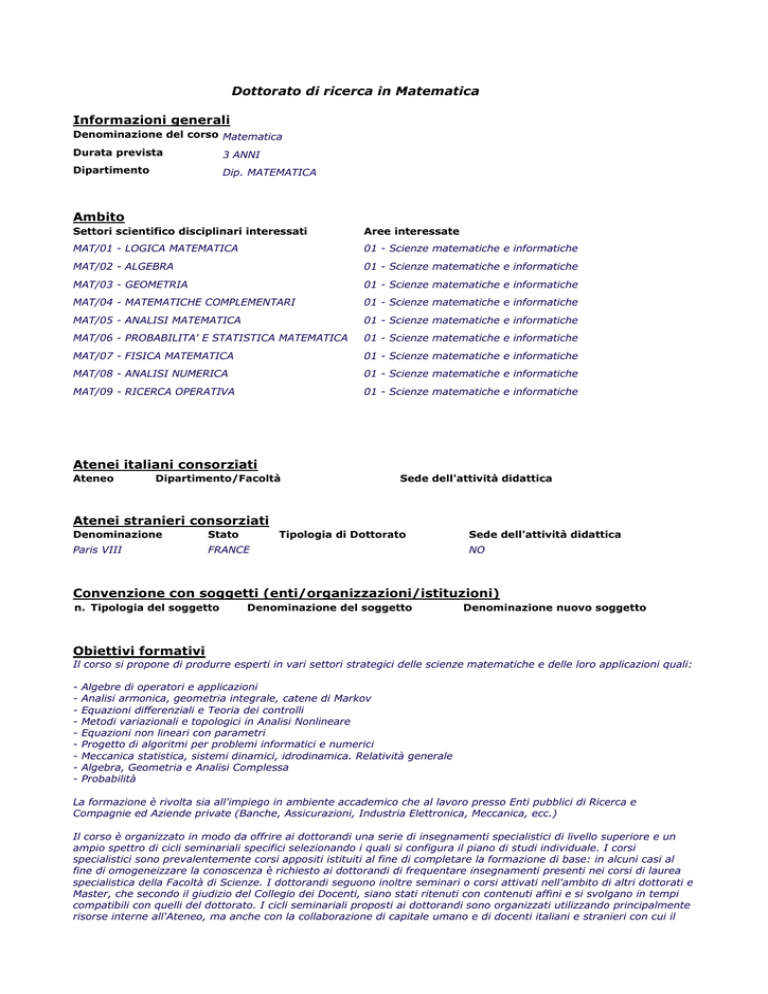
Dottorato di ricerca in Matematica
Informazioni generali
Denominazione del corso Matematica
Durata prevista
3 ANNI
Dipartimento
Dip. MATEMATICA
Ambito
Settori scientifico disciplinari interessati
Aree interessate
MAT/01 - LOGICA MATEMATICA
01 - Scienze matematiche e informatiche
MAT/02 - ALGEBRA
01 - Scienze matematiche e informatiche
MAT/03 - GEOMETRIA
01 - Scienze matematiche e informatiche
MAT/04 - MATEMATICHE COMPLEMENTARI
01 - Scienze matematiche e informatiche
MAT/05 - ANALISI MATEMATICA
01 - Scienze matematiche e informatiche
MAT/06 - PROBABILITA' E STATISTICA MATEMATICA
01 - Scienze matematiche e informatiche
MAT/07 - FISICA MATEMATICA
01 - Scienze matematiche e informatiche
MAT/08 - ANALISI NUMERICA
01 - Scienze matematiche e informatiche
MAT/09 - RICERCA OPERATIVA
01 - Scienze matematiche e informatiche
Atenei italiani consorziati
Ateneo
Dipartimento/Facoltà
Sede dell'attività didattica
Atenei stranieri consorziati
Denominazione
Stato
Tipologia di Dottorato
Paris VIII
FRANCE
Sede dell'attività didattica
NO
Convenzione con soggetti (enti/organizzazioni/istituzioni)
n. Tipologia del soggetto
Denominazione del soggetto
Denominazione nuovo soggetto
Obiettivi formativi
Il corso si propone di produrre esperti in vari settori strategici delle scienze matematiche e delle loro applicazioni quali:
-
Algebre di operatori e applicazioni
Analisi armonica, geometria integrale, catene di Markov
Equazioni differenziali e Teoria dei controlli
Metodi variazionali e topologici in Analisi Nonlineare
Equazioni non lineari con parametri
Progetto di algoritmi per problemi informatici e numerici
Meccanica statistica, sistemi dinamici, idrodinamica. Relatività generale
Algebra, Geometria e Analisi Complessa
Probabilità
La formazione è rivolta sia all'impiego in ambiente accademico che al lavoro presso Enti pubblici di Ricerca e
Compagnie ed Aziende private (Banche, Assicurazioni, Industria Elettronica, Meccanica, ecc.)
Il corso è organizzato in modo da offrire ai dottorandi una serie di insegnamenti specialistici di livello superiore e un
ampio spettro di cicli seminariali specifici selezionando i quali si configura il piano di studi individuale. I corsi
specialistici sono prevalentemente corsi appositi istituiti al fine di completare la formazione di base: in alcuni casi al
fine di omogeneizzare la conoscenza è richiesto ai dottorandi di frequentare insegnamenti presenti nei corsi di laurea
specialistica della Facoltà di Scienze. I dottorandi seguono inoltre seminari o corsi attivati nell'ambito di altri dottorati e
Master, che secondo il giudizio del Collegio dei Docenti, siano stati ritenuti con contenuti affini e si svolgano in tempi
compatibili con quelli del dottorato. I cicli seminariali proposti ai dottorandi sono organizzati utilizzando principalmente
risorse interne all'Ateneo, ma anche con la collaborazione di capitale umano e di docenti italiani e stranieri con cui il
Dipartimento di Matematica ha rapporti di collaborazione nell'ambito della ricerca.
Ogni dottorando è aiutato da un Tutor nella compilazione del suo piano di studi, soprattutto nella scelta delle attività
formative integrative.
I dottorandi svolgono nel corso della loro attività triennale un progetto di ricerca originale, con contenuti innovativi, in
modo indipendente.
In accordo col docente che ha funzioni di tutor, ogni dottorando sviluppa un progetto di ricerca, pianificandone le
diverse fasi di sviluppo.
Alla fine di ogni anno di corso, ciascun dottorando presenta una relazione e tiene un colloquio atto a verificare lo stato
di avanzamento della ricerca e il grado di preparazione raggiunto.
Durante il triennio i dottorandi producono pubblicazioni scientifiche inerenti all' attività di ricerca svolta e finalizzata
alla produzione della tesi finale. I risultati ottenuti nell'ambito della ricerca vengono inoltre presentati dai dottorandi
nel corso di convegni scientifici nazionali e internazionali.
Accogliendo i suggerimenti presenti nelle linee guida per la politica scientifica e tecnologica del governo, riguardante i
rapporti di collaborazione internazionale, il nostro dottorato ha ammesso dottorandi provenienti da altri paesi.
Nell'ultimo ciclo ha acquisito due dottorandi provenienti da Iraq e Libia, dotati di borse di studio di enti esterni,
sfruttando i posti in esubero previsti dal bando.
Nell'ultimo ciclo (XIX) il nostro dottorato ha anche accettato un dottorato in co-tutela con un'università francese.
Tematiche di ricerca
Coordinatore responsabile
Cognome
NACINOVICH
Nome
Mauro
Ateneo
Università degli Studi di ROMA "Tor Vergata"
Dipartimento Dip. MATEMATICA
Ruolo
Prof. ordinario
Settore
MAT/03
Partecipanti il collegio (personale di ruolo nelle università italiane)
n. Cognome
Nome
Ateneo
Dipartimento
Ruolo Settore
1. BELLETTINI
Giovanni
Università degli Studi di ROMA
"Tor Vergata"
DIP. MATEMATICA
PO
MAT/05
2. CANNARSA
Piermarco
Università degli Studi di ROMA
"Tor Vergata"
DIP. MATEMATICA
PO
MAT/05
3. CARAMELLINO
Lucia
Università degli Studi di ROMA
"Tor Vergata"
DIP. MATEMATICA
PA
MAT/06
4. CILIBERTO
Ciro
Università degli Studi di ROMA
"Tor Vergata"
DIP. MATEMATICA
PO
MAT/03
5. LIVERANI
Carlangelo
Università degli Studi di ROMA
"Tor Vergata"
DIP. MATEMATICA
PO
MAT/07
6. NACINOVICH
Mauro
Università degli Studi di ROMA
"Tor Vergata"
DIP. MATEMATICA
PO
MAT/03
7. OLIVIERI
Enzo
Università degli Studi di ROMA
"Tor Vergata"
DIP. MATEMATICA
PO
MAT/07
8. PARESCHI
Giuseppe
Università degli Studi di ROMA
"Tor Vergata"
DIP. MATEMATICA
PO
MAT/03
Università degli Studi di ROMA
"Tor Vergata"
DIP. INGEGNERIA
CIVILE
PO
ICAR/08
9. PODIO GUIDUGLI Paolo
10. ROBERTS
John Elias
Università degli Studi di ROMA
"Tor Vergata"
DIP. MATEMATICA
PO
MAT/05
11. SCHOOF
Renatus
Johannes
Università degli Studi di ROMA
"Tor Vergata"
DIP. MATEMATICA
PO
MAT/03
12. SINESTRARI
Carlo
Università degli Studi di ROMA
"Tor Vergata"
DIP. MATEMATICA
PO
MAT/05
13. STRICKLAND
Elisabetta
Università degli Studi di ROMA
"Tor Vergata"
DIP. MATEMATICA
PO
MAT/02
14. TARANTELLO
Gabriella
Università degli Studi di ROMA
"Tor Vergata"
DIP. MATEMATICA
PO
MAT/05
Personale appartenente ad Università Straniere
n. Cognome
Nome
Struttura
Dipartimento
Ruolo
Settore
Partecipanti il collegio (personale non di ruolo nelle università o dipendente di altri
enti)
n. Cognome
Nome
Struttura
Dipartimento
Ruolo
Settore
Requisiti richiesti per l'ammissione
VECCHIO ORDINAMENTO:
Tutte le lauree
SI
Se non tutte consentono l'accesso,
indicare quelle che lo consentono
NUOVO ORDINAMENTO:
Tutte le lauree
SI
Se non tutte consentono l'accesso,
indicare quelle che lo consentono
Altro per studenti stranieri
Dichiarazione di Valore;
Equipolenza della Laurea alle Lauree Vecchio Ordinamento o Specialistiche.
Altro
Modalità di ammissione
Analisi titoli,
Prova scritta,
Orale,
Lingua
Per i candidati stranieri (se diversa da quella per i candidati italiani)
Analisi titoli,
Orale,
Lingua
Attività
Attività didattica prevista
-Insegnamenti previsti nell'iter formativo
-Insegnamenti mutuati da corsi di laurea
Cicli seminariali
SI
Obbligatorio
tot CFU 15 n.ro insegnamenti 5
SI
n.ro 3
SI
n.ro 1
Verifiche annuali previste
Numero totale delle verifiche
SI
n.ro 1
3
Stage presso
Soggiorni all'estero
-Periodo consentito all'estero (in mesi)
SI
Non Obbligatorio
min: 1
max: 12
-Finalità del soggiorno all'estero
Attività di ricerca
Produzione scientifica del collegio dal 1999 al 2004 (personale di ruolo nelle
università italiane)
1. ALABAU F., CANNARSA P., KOMORNIK V. (2002). Indirect internal stabilization of weakly coupled systems of
evolution equations. JOURNAL OF EVOLUTION EQUATIONS. vol. 2, pp. 127-150.
2. ALBANO P., CANNARSA P. (1999). Structural properties of singularities of semiconcave functions. ANNALI DELLA
SCUOLA NORMALE SUPERIORE DI PISA CLASSE DI SCIENZE. vol. 28, pp. 719-740.
3. ALBANO P., CANNARSA P. (2002). Propagation of singularities for solutions of nonlinear first order partial
differential equations. ARCHIVE FOR RATIONAL MECHANICS AND ANALYSIS. vol. 162, pp. 1-23.
4. ALBANO P., CANNARSA P., SINESTRARI C. (2000). Regularity Results for the Minimum Time Function of a Class of
Semilinear Evolution Equations of Parabolic Type. SIAM J. CONTROL OPTIMIZ. vol. 38, pp. 916-946.
5. BARRON E.N., CANNARSA P., JENSEN R., SINESTRARI C. (1999). Regularity of Hamilton-Jacobi equations when
forward is backward. INDIANA UNIVERSITY MATHEMATICS JOURNAL. vol. 48, pp. 385-409.
6. BELLETTINI G., BUTTA' P., PRESUTTI E. (2001). Sharp interface limits of non local anisotropic interactions.
ARCHIVE FOR RATIONAL MECHANICS AND ANALYSIS. vol. 159, pp. 109-135.
7. BELLETTINI G., GOGLIONE R., NOVAGA M. (2000). Approximation and comparison for non-smooth anisotropic
motion by mean curvature in R^N. MATHEMATICAL MODELS & METHODS IN APPLIED SCIENCES. vol. 10, pp. 110.
8. BELLETTINI G., NOVAGA M. (1999). A result on motion by mean curvature in arbitrary codimension. DIFFERENTIAL
GEOMETRY AND ITS APPLICATIONS. vol. 11, pp. 205-220.
9. BELLETTINI G., NOVAGA M., PAOLINI M. (2001). On a crystalline variational problem, part I: first variation and
global L^infty regularity. ARCHIVE FOR RATIONAL MECHANICS AND ANALYSIS. vol. 157, pp. 165-191.
10. BELLETTINI G., NOVAGA M., PAOLINI M. (2001). On a crystalline variational problem, part II: BV-regularity and
structure of minimizers on facets. ARCHIVE FOR RATIONAL MECHANICS AND ANALYSIS. vol. 157, pp. 193-217.
11. C.D.Hill, NACINOVICH M. (1999). Leray residues and Abel\'s Theorem in CR codimension k. ANNALI DI
MATEMATICA PURA ED APPLICATA. vol. CLXXVI, pp. 287-322.
12. C.Medori, NACINOVICH M. (2002). The Levi-Malcev theorem for graded CR Lie algebras. RESEARCH AND
EXPOSITION IN MATHEMATICS. vol. 25, pp. 341-346.
13. CANNARSA P., KOMORNIK V., LORETI P. (2002). One-sided and internal controllability of semilinear wave
equations with infinitely iterated logarithms. DISCRETE AND CONTINUOUS DYNAMICAL SYSTEMS. vol. 8, pp. 745756.
14. CANNARSA P., PEIRONE R. (2001). Unbounded components of the singular set of the distance function in R^n.
TRANSACTIONS OF THE AMERICAN MATHEMATICAL SOCIETY. vol. 353, pp. 4567-4581.
15. CANNARSA P., PIGNOTTI C., SINESTRARI C. (2000). Semiconcavity for optimal control problems with exit time.
DISCRETE AND CONTINUOUS DYNAMICAL SYSTEMS. vol. 4, pp. 975-997.
16. CANNARSA P., PIGNOTTI C., SINESTRARI C. (2000). Semiconcavity for optimal control problems with exit time.
DISCRETE AND CONTINUOUS DYNAMICAL SYSTEMS. vol. 6, pp. 975-997.
17. CANNARSA P., SFORZA D. (2003). Global solution of a class of semilinear heat equations for materials of fading
memory type. NODEA. NONLINEAR DIFFERENTIAL EQUATIONS AND APPLICATIONS. vol. 10, pp. 399-430.
18. CANNARSA P., SINESTRARI C. (2004). Semiconcave functions, Hamilton-Jacobi equations, and optimal control.
ISBN: 0-8176-4084-3 Progress in Nonlinear Differential Equations and their Applications, vol.58. BOSTON:
Birkhäuser (UNITED STATES).
19. CARAMELLINO L., A. CLIMESCU-HAULICA, B. PACCHIAROTTI. (1999). Diffusion approximations for random walks
on nilpotent Lie groups. STATISTICS & PROBABILITY LETTERS. vol. 41, pp. 363-377.
20. CARAMELLINO L., B. PACCHIAROTTI. (2002). Weak approximation of a Brownian motion killed on time-dependent
barriers. MONTE CARLO METHODS AND APPLICATIONS. vol. 8, pp. 221-237.
21. CARAMELLINO L., M.G. IOVINO. (2002). An exit-probability-based approach for the valuation of defaultable
securities. JOURNAL OF COMPUTATIONAL FINANCE. vol. 6, pp. 1-24.
22. CARAMELLINO L., V. DI VINCENZO. (2001). A law of the Iterated Logarithm for random walks on nilpotent Lie
groups. BERNOULLI. vol. 7, pp. 605-628.
23. CILIBERTO C., A. CALABRI. (2001). On special projections of varieties: epitome to a theorem of Beniamino Segre.
ADVANCES IN GEOMETRY. vol. 1, pp. 97-106.
24. CILIBERTO C., A. LOPEZ. (2002). On the number of moduli of extendable canonical curves. NAGOYA
MATHEMATICAL JOURNAL. vol. 167, pp. 101-115.
25. CILIBERTO C., E. SERNESI. (2000). On the geometry of canonical curves of odd genus. COMMUNICATIONS IN
ALGEBRA. vol. 28(12), pp. 5993-6002.
26. CILIBERTO C., L. CHIANTINI. (2001). Weakly defective varieties. TRANSACTIONS OF THE AMERICAN
MATHEMATICAL SOCIETY. vol. 354, pp. 151-178.
27. CILIBERTO C., L. CHIANTINI. (2002). The Grassmannians of secant varieties of curves are not defective.
INDAGATIONES MATHEMATICAE-NEW SERIES. vol. 13(1), pp. 23-28.
28. CILIBERTO C., M. MELLA, F. RUSSO. (2004). Varieties with one apparent double point. JOURNAL OF ALGEBRAIC
GEOMETRY. vol. 13, pp. 475-512.
29. CILIBERTO C., M. MENDES LOPES. (2000). On the classification of regular surfaces of general type with non
birational canonical map and pg=. JOURNAL OF MATHEMATICS OF KYOTO UNIVERSITY. vol. 40(1), pp. 79-117.
30. CILIBERTO C., M. MENDES LOPES. (2002). On surfaces with pg=q=2 and non-birational bicanonical map.
ADVANCES IN GEOMETRY. vol. 2, pp. 281-300.
31. CILIBERTO C., M. ZAIDENBERG. (2003). 3-fold symmetric products of curves as hyperbolic hypersurfaces in
$Proj^4$. INTERNATIONAL JOURNAL OF MATHEMATICS. vol. 14(4), pp. 413-436.
32. CILIBERTO C., R. PARDINI, F. TOVENA. (2000). Prym varieties and the canonical map of surfaces of general type.
ANNALI SCUOLA NORMALE SUPERIORE DI PISA. vol. (4)29, pp. 905-938.
33. CILIBERTO C., R.MIRANDA. (2000). Linear systems of plane curves with base points of equal multiplicity.
TRANSACTIONS OF THE AMERICAN MATHEMATICAL SOCIETY. vol. 352, pp. 4037-4050.
34. CILIBERTO C., S. GRECO. (2000). On normal surface singularities and a problem of Enriques. COMMUNICATIONS
IN ALGEBRA. vol. 28(12), pp. 5891-5914.
35. CILIBERTO C., V. DI GENNARO. (2002). Boundedness for codimension two subvarieties. INTERNATIONAL JOURNAL
OF MATHEMATICS. vol. 13(5), pp. 479-495.
36. CILIBERTO C., V. DI GENNARO. (2002). Boundedness for surfaces on smooth fourfolds. JOURNAL OF PURE AND
APPLIED ALGEBRA. vol. 173, pp. 273-279.
37. ETINGOF P., STRICKLAND E. (2003). Lectures on quasi-invariants of Coxeter groups and the Cherednik algebra.
ENSEIGNEMENT MATHÉMATIQUE. vol. 49n.1-2, pp. 35-65.
38. F.FIDALEO, LIVERANI C. (2003). Ergodic properties of a model related to disordered quantum anharmonic crystals.
COMMUNICATIONS IN MATHEMATICAL PHYSICS. vol. 2235, pp. 169-189.
39. FIDALEO F., LIVERANI C. (1999). Ergodic properties for a quantum non linear dynamics. JOURNAL OF
STATISTICAL PHYSICS. vol. 97, 5/6, pp. 957-1009.
40. G. BOFFI, A. RAGUSA, STRICKLAND E., G. VALLA, EDITORS. (2000). Commutative algebra, homological algebra
and Representation theory. Selected papers from the three interconnected sub-conferences held at the Universities
of Catania, Genoa and Rome "Tor Vergata", Catania, Genoa, Rome. J. of pure and applied Algebra. (vol. 152, pp.
1-344). Strickland partecipa come editore degli atti.
41. G.G.N. ANGILELLA, G. BALESTRINO, P. CERMELLI, PODIO GUIDUGLI P., A.A. VARLAMOV. (2002). Effect of straininduced electronic topological transitions on the superconducting properties of La_{2-x}Sr_{x}CuO_{4} thin films.
EUROPEAN PHYSICAL JOURNAL B. vol. 26, pp. 67-74.
42. HILL C.D., NACINOVICH M. (2000). A weak pseudoconcavity condition for abstract almost CR manifolds.
INVENTIONES MATHEMATICAE. vol. 142, pp. 251-283.
43. HUISKEN G., SINESTRARI C. (1999). Convexity estimates for mean curvature flow and singularities of mean
convex surfaces. ACTA MATHEMATICA. vol. 183, pp. 45-70.
44. JENSSEN H.K., SINESTRARI C. (2001). On the spreading of characteristics for non-convex conservation laws.
PROCEEDINGS OF THE ROYAL SOCIETY OF EDINBURGH SECTION A-MATHEMATICS. vol. 131, pp. 909-925.
45. KELLER G., LIVERANI C. (1999). Stability of the spectrum for transfer operators. ANNALI DELLA SCUOLA NORMALE
SUPERIORE DI PISA. vol. XXVIII, pp. 141-152.
46. LIVERANI C. (2000). Interacting particles.
In D.SZASZ EDITOR. Hard Balls Systems and the Lorentz gas. (vol. 101, pp. 145-179). HEILDERBERG: Springer
(GERMANY).
47. LIVERANI C. (2001). Rigorous numerical investigation of the statistical properties of piecewise expanding maps--A
feasibility study. NONLINEARITY. vol. 14, n. 3, pp. 463-490.
48. LIVERANI C. (2004). Birth of an elliptic island in a chaotic sea. MATHEMATICAL PHYSICS ELECTRONIC JOURNAL.
vol. 10 numero 1.
49. LIVERANI C. (2004). Invariant measures and their properties. A functional analytic point of view.
In VARI. Dynamical Systems. Part II: Topological Geometrical and Ergodic Properties of Dynamics. Pubblicazioni
della Classe di Scienze, Scuola Normale Superiore, Pisa. Centro di Ricerca Matematica "Ennio De Giorgi" :
Proceedings. Published by the Scuola Normale Superiore in Pisa (2004). (vol. II). PISA: Scuola Normale Superiore
in Pisa (ITALY).
50. LIVERANI C., V. MAUME-DESCHAMPS. (2003). Lasota-Yorke maps with holes: conditionally invariant probability
measures and invariant probability measures on the survivor set. ANNALES DE L'INSTITUT HENRI POINCARE (B)
PROBABILITY AND STATISTICS. vol. 39 (3), pp. 385-412.
51. M.BLANK, G.KELLER, LIVERANI C. (2002). Ruelle-Perron-Frobenius spectrum for Anosov maps. NONLINEARITY.
vol. 15, pp. 1905-1973 numero 6.
52. MEDORI C, NACINOVICH M. (2000). Complete nondegenerate locally standard CR manifolds. MATHEMATISCHE
ANNALEN. vol. 317, pp. 509-526.
53. MEDORI C, NACINOVICH M. (2001). Maximally homogeneous nondegenerate CR manifolds. ADVANCES IN
GEOMETRY. vol. I, pp. 89-95.
54. MEDORI C, NACINOVICH M. (2001). Standard CR manifolds of codimension 2. TRANSFORMATION GROUPS. vol. 6,
pp. 53-78.
55. NACINOVICH M., HILL C.D. (2003). Weak pseudoconcavity and the maximum modulus principle. ANNALI DI
MATEMATICA PURA ED APPLICATA. vol. 182, pp. 103-112.
56. P. BALDI, CARAMELLINO L. (1999). Large and moderate deviations for random walks on nilpotent Lie groups.
JOURNAL OF THEORETICAL PROBABILITY. vol. 12, pp. 779-809.
57. P. BALDI, CARAMELLINO L. (2002). Asymptotics of hitting probabilities for general one-dimensional diffusions.
ANNALS OF APPLIED PROBABILITY. vol. 12, pp. 1071-1095.
58. P. BALDI, CARAMELLINO L., M. G. IOVINO. (1999). Pricing complex barrier options with general features using
sharp large deviation estimates. Monte Carlo and Quasi-Monte Carlo Methods 1998. 1998. (pp. 149-162). H.
Niederreiter-J. Spanier (Eds.), Springer.
59. P. BALDI, CARAMELLINO L., M. G. IOVINO. (1999). Pricing general barrier options: a numerical approach using
Sharp Large Deviations. MATHEMATICAL FINANCE. vol. 9, pp. 293-322.
60. P. CERMELLI, PODIO GUIDUGLI P. (2002). Modeling deformation effects on T_{c} in epitaxial films of
La_{1.9}Sr_{0.1}CuO_{4}. PHYSICA C. vol. 371, pp. 117-128.
61. PARESCHI G. (1999). Picard bundles and syzygies of canonical curves.
In VAN OYSTAEYEN F. Commutative algebra and algebraic geometry. (vol. 206, pp. 227-236). ISBN: 0-82471990-5 NEW YORK: Marcel Dekker, Inc. (UNITED STATES).
62. PARESCHI G., POPA M. (2000). Syzygies of abelian varieties. JOURNAL OF THE AMERICAN MATHEMATICAL
SOCIETY. vol. 13, pp. 651-664.
63. PARESCHI G., POPA M. (2003). Regularity on abelian varieties, I. JOURNAL OF THE AMERICAN MATHEMATICAL
SOCIETY. vol. 16, pp. 185-302.
64. PARESCHI G., POPA M. (2004). Regularity on abelian varieties II: Basic results on linear series and defining
equations. JOURNAL OF ALGEBRAIC GEOMETRY. vol. 13, pp. 167-193.
65. PINZARI., C., ROBERTS J.E., J.E. (2002). Regular Objects, Multiplicative Unitaries and Conjugation.
INTERNATIONAL JOURNAL OF MATHEMATICS. vol. 13, pp. 625-665.
66. PODIO GUIDUGLI P. (2001). Configurational balances via variational arguments. INTERFACE AND FREE
BOUNDARIES. vol. 3, pp. 1-10.
67. PODIO GUIDUGLI P. (2003). A new quasilinear model for plate buckling. JOURNAL OF ELASTICITY. vol. 71, pp.
157-182.
68. PODIO GUIDUGLI P., TOMASSETTI G. (2004). On the evolution of domain walls in hard ferromagnets, in corso di
pubbl. su SIAM Journal of Applied Mathematics (2004). SIAM JOURNAL ON APPLIED MATHEMATICS. (in corso di
pubblicazione).
69. ROBERTS J.E. (2004). More Lectures on Algebraic Quantum Field Theory. SPRINGER LECTURE NOTES IN
MATHEMATICS. vol. 1831, pp. 263-342 In: Noncommutative Geometry, ed. Doplicher, S., Longo, R.
70. ROBERTS J.E., D., DOPLICHER, S., MORCHIO, G., ROBERTS, J.E., STROCCHI, F. (2001). Quantum Delocalization of
Electric Charge. ANNALS OF PHYSICS. vol. 290, pp. 53-66.
71. ROBERTS J.E., D., LONGO, R., ROBERTS, J.E., VERCH, R. (2001). Charged Sectors, Spin and Statistics in Quantum
Field Theory on Curved Spacetimes. REVIEWS IN MATHEMATICAL PHYSICS. vol. 13, pp. 125-198.
72. ROBERTS J.E., J.E., TUSET, L. (2001). On the equality of q-dimension and intrinsic dimension. JOURNAL OF PURE
AND APPLIED ALGEBRA. vol. 156, pp. 329-343.
73. ROBERTS J.E., R., DOPLICHER, S., ROBERTS, J.E. (2001). Superselection Theory for Subsystems.
COMMUNICATIONS IN MATHEMATICAL PHYSICS. vol. 218, pp. 263-281.
74. ROBERTS J.E., S., PINZARI, C., ROBERTS, J.E. (2001). An Algebraic Duality Theory for Multiplicative Unitaries.
INTERNATIONAL JOURNAL OF MATHEMATICS. vol. 12, pp. 415-459.
75. SAUSSOL B., LIVERANI C., VAIENTI S. (1999). A Probabilistic Approach to Intermittency. ERGODIC THEORY AND
DYNAMICAL SYSTEMS. vol. 19, pp. 671-685.
76. SCHOOF R. (2001). Abelian varieties over the field of the 20th roots of unity with good reduction everywhere.
Applications of Algebraic Geometry to Coding Theory, Physics and Computation. (pp. 291-296). Proceedings of the
NATO advanced research workshop, Kluwer 2001.
77. SCHOOF R. (2001). Finite flat group schemes of Artin rings. COMPOSITIO MATHEMATICA. vol. 128, pp. 1-15.
78. SCHOOF R. (2001). abelian varieties with good reduction everywhere over Q(sqrt(6)). Class field theory-Its
centenary and prospect. (pp. 287-306). Advanced Studies in Pure Math., Math.Soc. Japan, Tokyo 2001.
79. SCHOOF R. (2002). Wiles's proof of the Taniyama-Weil conjecture for semi-stable elliptic curves over Q.
In ED. Ou' en sont les mathe'matiuques. (pp. 305-326). ISBN: 2-7117-8994-2 Publication SMF. PARIS: Vuibert.
80. SCHOOF R. (2003). Abelian varieties over cyclotomic fields with good reduction everywhere. MATHEMATISCHE
ANNALEN. vol. 325, pp. 413-448.
81. SCHOOF R. (2003). Class groups of real cyclotomic fields of prime conductor. MATHEMATICS OF COMPUTATION.
vol. 72, pp. 913-937.
82. SCHOOF R. (2004). Computing Arakelov class groups. MSRI workshop computational number theory. (pp. 1-33).
83. SCHOOF R., E. BAYERFLUCKIGER, M. MONSURRO' R. PARIMALA. (2004). Trace forms of G-Galois algebras in
virtual cohomological dimension 1 and 2,. PACIFIC JOURNAL OF MATHEMATICS. To appear.
84. SCHOOF R., LARIO J.C. (2002). Computations with Hecke rings and deformation rings. IN. vol. 11, pp. 303-312
Journal of experimental Mathematics.
85. SINESTRARI C. (1999). Layering methods for Hamilton-Jacobi equations with nonconvex Hamiltonian. NONLINEAR
ANALYSIS-THEORY METHODS & APPLICATIONS. vol. 38, pp. 137-149.
86. STRICKLAND E. (2000). Quotients of flag varieties by a maximal torus. MATHEMATISCHE ZEITSCHRIFT. vol. 234
n.1, pp. 1-7.
87. STRICKLAND E. (2002). Lines G/P. MATHEMATISCHE ZEITSCHRIFT. vol. 242 n.2, pp. 227-240.
88. V. BALLY, CARAMELLINO L., A. ZANETTE. (?). Pricing and hedging American options by Monte Carlo methods using
a Malliavin calculus approach. 2003. (pp. 1-40). preprint INRIA.
89. X. BRESSAUD, LIVERANI C. (2002). Anosov diffeomorphism and coupling. ERGODIC THEORY AND DYNAMICAL
SYSTEMS. vol. 22, pp. 129-152 numero 1.

